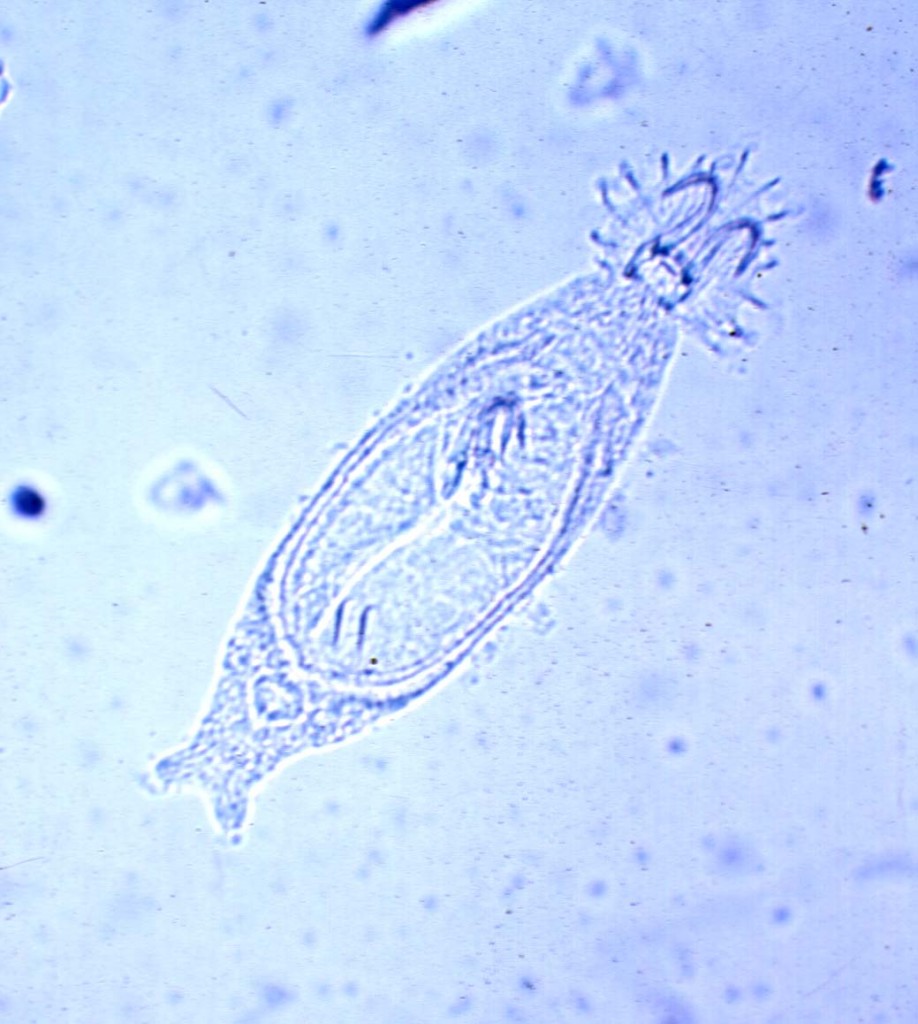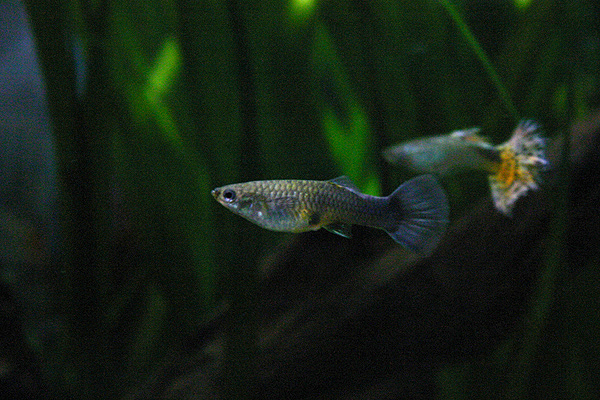Little fish are the fun-sized candy bars of the aquatic world. They’re prey for just about everything, from larger fish to insects. To get by in a dangerous world, small fish tend to form groups called shoals. Shoals are great for numerous reasons. When a predator shows up, each individual’s probability of being consumed decreases as shoal size increases, and the frantic movements of a large group of fish may confuse the predator, saving everyone. Unfortunately for the fish, group living carries some significant costs.
Enter the parasites
Fish are hosts for tons of parasites, many of which require fish to be in close proximity for transmission. A particularly cool, socially transmitted parasite group are the Gyrodactylids.
 Gyrodactylids are monogenean parasites, which use a series of hooks to hold onto the fish’s gills or skin. As if the hooks aren’t bad enough, they essentially spit a concoction onto the fish that dissolves its skin or gills, preparing a delicious fish slurry which gets sucked up by the parasite. In small numbers their effects are fairly negligible, but they can easily kill a fish at high densities.
Gyrodactylids are monogenean parasites, which use a series of hooks to hold onto the fish’s gills or skin. As if the hooks aren’t bad enough, they essentially spit a concoction onto the fish that dissolves its skin or gills, preparing a delicious fish slurry which gets sucked up by the parasite. In small numbers their effects are fairly negligible, but they can easily kill a fish at high densities.
Gyrodactylid parasites, unlike other monogeneans, have a special trick for reaching high densities quickly. Gyrodactylids can give birth to fully grown, already “pregnant” offspring! Much like Russian dolls, one parasite can harbor multiple generations of future parasites, each of which is beginning to produce embryos of their own even before they’ve been birthed. Beat that, Octomom!
Social behavior and parasite risk
Gyrodactylids can’t move great distances, so they can only infect a new host if it gets in close proximity. So while shoaling is great for reducing predator risk, it has big costs in terms of parasite transmission. Most fish will try avoiding infected individuals, but it’s not always easy to do.
 In guppies, females and males differ in their shoaling behavior, and thus their risk of parasitism by Gyrodactylus turnbulli (see paper by Richards and colleagues here). Females spend more time in the shoal, and get closer to shoal-mates than do males. Males probably shoal less for two reasons. First, guppies breed year-round, and being around other males means that you’re hanging out with the competition. So males typically don’t spend a great deal of time together. Second, the females don’t want the males hanging around either. Male guppies have a reproductive structure called a gonopodium, which is essentially a modified fin which allows them to insert spermatozoa into the female. Males can deposit spermatozoa so quickly, in fact, that they can swim up to a female, deposit this unexpected package, and then swim off before the female knows what happened. Because of these “sneaky matings”, females aren’t particularly excited about male shoal-members.
In guppies, females and males differ in their shoaling behavior, and thus their risk of parasitism by Gyrodactylus turnbulli (see paper by Richards and colleagues here). Females spend more time in the shoal, and get closer to shoal-mates than do males. Males probably shoal less for two reasons. First, guppies breed year-round, and being around other males means that you’re hanging out with the competition. So males typically don’t spend a great deal of time together. Second, the females don’t want the males hanging around either. Male guppies have a reproductive structure called a gonopodium, which is essentially a modified fin which allows them to insert spermatozoa into the female. Males can deposit spermatozoa so quickly, in fact, that they can swim up to a female, deposit this unexpected package, and then swim off before the female knows what happened. Because of these “sneaky matings”, females aren’t particularly excited about male shoal-members.
Richards and colleagues experimentally infected 1 male or 1 female in same sex shoals with oodles of Gyrodactylus turnbulli, and found that previously uninfected female shoal mates were 4 times more likely to become infected by the parasite than were males. This is likely because females come in contact with one another much more frequently, allowing the parasite to jump ship from one female, and settle down on her shoal-mate.
But that doesn’t mean that the males are off the hook. Females may be more likely to encounter the parasite, but infected males are more likely to harbor high density infections. Individual females occasionally dump some of their parasites off onto another shoal-mates, decreasing the density of parasites they themselves harbor. Because males rarely buddy up with other males, all of the parasites they harbor stay on that male, allowing the parasite to reach high densities. It also seems possible that males are less efficient at mounting an immune response to the parasite (males across the animal kingdom seem more susceptible to parasites, presumably because of the immunosuppressive effects of testosterone).
The authors of this study looked at parasite transmission in only same-sex shoals. I hope that, in future studies, they’ll look at mixed sex shoals (i.e., males and females) because there are almost certainly some interesting parasite transmission dynamics going on between the sexes. Sneaky males may surprise females with not only unexpected sperm, but also an unexpected gyrodactylid STD. Additionally, the observation that males harbor higher parasite population densities might not hold up when males have the chance to transfer parasites to females in the population. Lots of cool work to do in the future!
If you think gyrodactylids are awesome, check out Joanne Cable’s website. She is a professor at Cardiff University who has done some really cool work in this system (including the study mentioned above).
Here is a video of a monogenean parasite moving around on a California killifish.

If a male infects a female with a parasite, wouldn’t you call that an STP?
Very cool.
I too avoid males when in large groups.
I don’t want to fall prey to sneaky matings. 🙂
As fascinating as the post was (and it was very cool!), I have to admit that I cracked up a bit when I realized that ‘Summer of ’69’ was playing in the background in that video.